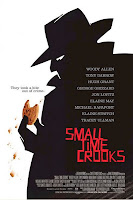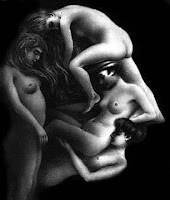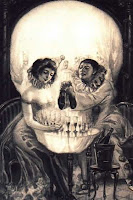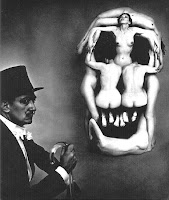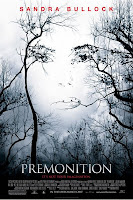An amusing side effect of the modern multiplex is the crowded marquee. Take a couple of proper name film titles and a verb-based film title, and then fit them in a confined space and titter at the accidental phrases that occasionally result. While this sort of thing has been fodder for 'funny photo' forums and obnoxious catch-all humor sites for years, last summer's release of the film Knocked Up made possible an unprecedented number of suggestive juxtapositions. Theater signs around the country seemed to be boasting more paternity claims than a TiVo filled with Maury Povich episodes.
In the interest of interest, I have put together what very well may be the most comprehensive collection of "naughty movie sign" photos anywhere. Here, then, is a rundown of various examples from the last seven years or so.
 Although short and sweet, this one gets bonus points for working on more than one level. Not only do you have a fine "Whoops! I'm pregnant!" double feature, but the sign simultaneously describes the premise of the second movie.
Although short and sweet, this one gets bonus points for working on more than one level. Not only do you have a fine "Whoops! I'm pregnant!" double feature, but the sign simultaneously describes the premise of the second movie.
 The beloved teen detective has grown up fast for this modern day film version. If only we had an idea of who was responsible for this predicament.
The beloved teen detective has grown up fast for this modern day film version. If only we had an idea of who was responsible for this predicament.
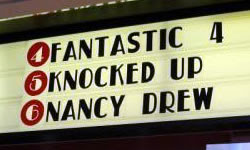 That's what you get for asking. It must've been one wild night. Either all four of them did the deed, or Johnny Storm is the culprit and the rest of the gang decided to share the blame as a show of team solidarity.
That's what you get for asking. It must've been one wild night. Either all four of them did the deed, or Johnny Storm is the culprit and the rest of the gang decided to share the blame as a show of team solidarity.
 Well, now it looks like the mysterious Mr. Brooks is also a candidate for fatherhood. The plot thickens.
Well, now it looks like the mysterious Mr. Brooks is also a candidate for fatherhood. The plot thickens.
 The boy wizard appears to be yet another suspect. This particular photo also gave birth to its own YTMND site. Click here if the preceding abbreviation looks like a keyboard spasm to you.
The boy wizard appears to be yet another suspect. This particular photo also gave birth to its own YTMND site. Click here if the preceding abbreviation looks like a keyboard spasm to you.
 A second claim of Mr. Brooks as the daddy. He's a dirty old man! There's even a blog named after this particular phrase.
A second claim of Mr. Brooks as the daddy. He's a dirty old man! There's even a blog named after this particular phrase.
 That would have to have been an immaculate conception.
That would have to have been an immaculate conception.
 What do you expect? They are pirates, after all.
What do you expect? They are pirates, after all.
 In case you were wondering where to start in getting someone knocked up.
In case you were wondering where to start in getting someone knocked up.
 A ringing endorsement for necrophilia.
A ringing endorsement for necrophilia.
 The blog where I found this photo hit the nail on the head in the original post: "Second-run movie theater marquee or worst personal ad ever?" Indeed.
The blog where I found this photo hit the nail on the head in the original post: "Second-run movie theater marquee or worst personal ad ever?" Indeed.
 Before Knocked Up came along, clever theater employees made the most out of the release of Blow.
Before Knocked Up came along, clever theater employees made the most out of the release of Blow.
 Those Spy Kids have fallen on hard times.
Those Spy Kids have fallen on hard times.
 Wow. That's a mouthful (shameless pun intended).
Wow. That's a mouthful (shameless pun intended).
 If they had put Just Visiting first it would've made a lovely souvenir postcard for a Tijuana brothel.
If they had put Just Visiting first it would've made a lovely souvenir postcard for a Tijuana brothel.
 This was the first "naughty movie sign" I saw online, circa the year 2000. It's still one of the best.
This was the first "naughty movie sign" I saw online, circa the year 2000. It's still one of the best.
 I may as well end on a dick joke.
I may as well end on a dick joke.
As a sidenote to this topic, here's a pair of photos showing some strategic poster placement in two different movie theaters. The trio of posters in both examples form the same subliminal suggestion. Superman Returns and Eragon are the first two films advertised, while the third poster is X-Men III and Pirates of the Caribbean 2, respectively.


Still want more? Check Your Local Listings, Part 2!
In the interest of interest, I have put together what very well may be the most comprehensive collection of "naughty movie sign" photos anywhere. Here, then, is a rundown of various examples from the last seven years or so.
 Although short and sweet, this one gets bonus points for working on more than one level. Not only do you have a fine "Whoops! I'm pregnant!" double feature, but the sign simultaneously describes the premise of the second movie.
Although short and sweet, this one gets bonus points for working on more than one level. Not only do you have a fine "Whoops! I'm pregnant!" double feature, but the sign simultaneously describes the premise of the second movie. The beloved teen detective has grown up fast for this modern day film version. If only we had an idea of who was responsible for this predicament.
The beloved teen detective has grown up fast for this modern day film version. If only we had an idea of who was responsible for this predicament. That's what you get for asking. It must've been one wild night. Either all four of them did the deed, or Johnny Storm is the culprit and the rest of the gang decided to share the blame as a show of team solidarity.
That's what you get for asking. It must've been one wild night. Either all four of them did the deed, or Johnny Storm is the culprit and the rest of the gang decided to share the blame as a show of team solidarity. Well, now it looks like the mysterious Mr. Brooks is also a candidate for fatherhood. The plot thickens.
Well, now it looks like the mysterious Mr. Brooks is also a candidate for fatherhood. The plot thickens. The boy wizard appears to be yet another suspect. This particular photo also gave birth to its own YTMND site. Click here if the preceding abbreviation looks like a keyboard spasm to you.
The boy wizard appears to be yet another suspect. This particular photo also gave birth to its own YTMND site. Click here if the preceding abbreviation looks like a keyboard spasm to you. A second claim of Mr. Brooks as the daddy. He's a dirty old man! There's even a blog named after this particular phrase.
A second claim of Mr. Brooks as the daddy. He's a dirty old man! There's even a blog named after this particular phrase. That would have to have been an immaculate conception.
That would have to have been an immaculate conception. What do you expect? They are pirates, after all.
What do you expect? They are pirates, after all. In case you were wondering where to start in getting someone knocked up.
In case you were wondering where to start in getting someone knocked up. A ringing endorsement for necrophilia.
A ringing endorsement for necrophilia. The blog where I found this photo hit the nail on the head in the original post: "Second-run movie theater marquee or worst personal ad ever?" Indeed.
The blog where I found this photo hit the nail on the head in the original post: "Second-run movie theater marquee or worst personal ad ever?" Indeed. Before Knocked Up came along, clever theater employees made the most out of the release of Blow.
Before Knocked Up came along, clever theater employees made the most out of the release of Blow. Those Spy Kids have fallen on hard times.
Those Spy Kids have fallen on hard times. Wow. That's a mouthful (shameless pun intended).
Wow. That's a mouthful (shameless pun intended). If they had put Just Visiting first it would've made a lovely souvenir postcard for a Tijuana brothel.
If they had put Just Visiting first it would've made a lovely souvenir postcard for a Tijuana brothel. This was the first "naughty movie sign" I saw online, circa the year 2000. It's still one of the best.
This was the first "naughty movie sign" I saw online, circa the year 2000. It's still one of the best. I may as well end on a dick joke.
I may as well end on a dick joke.As a sidenote to this topic, here's a pair of photos showing some strategic poster placement in two different movie theaters. The trio of posters in both examples form the same subliminal suggestion. Superman Returns and Eragon are the first two films advertised, while the third poster is X-Men III and Pirates of the Caribbean 2, respectively.


Still want more? Check Your Local Listings, Part 2!





